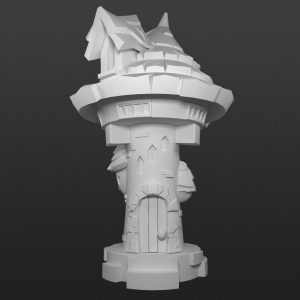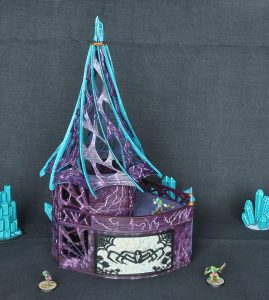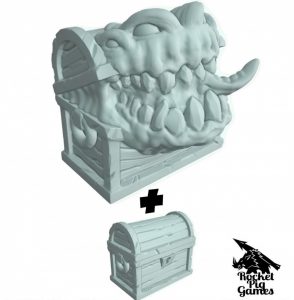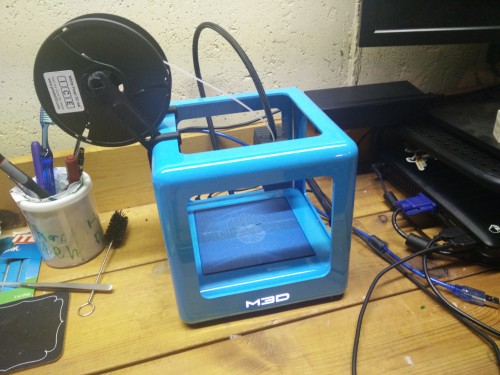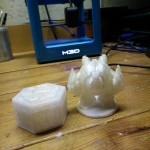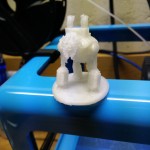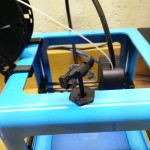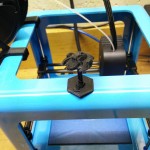Hobgoblin 3D offers a variety of 3D printable terrain elements (STL models) for fantasy miniature setups. There are floor tiles, a pile of treasure, a barrel, and a few other such mundane items but the company’s real specialty seems to be Gothic-style furniture and architectural elements, like this sarcophagus.
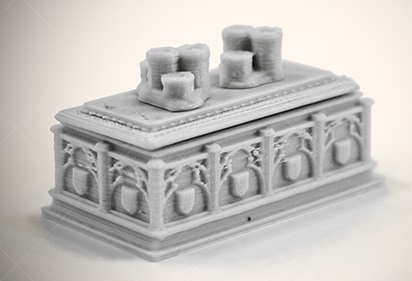
- Comments Off on Hobgoblin 3D Printables
3D Printing Roundup
19 Sep
Posted by David Miller as Miniatures, Modern Board Games, RPGs, War Games
A number of sources are now offering 3D printing models (STL files) via DriveThruRPG or Wargame Vault.
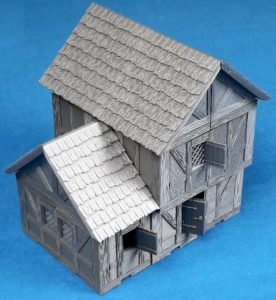 Fat Dragon Games, a company that started with print-and-play paper models, has the Dragonlock line, which includes both monster figures ($5 for five figures) and dungeon terrain ($10-20 per set). The dungeon terrain sets include stone walls, pillars, stairways, natural caverns, and also hazards, traps, and accouterments such as a treasure chest and an altar. Dungeon levels are stackable and sections can be held together with printable clips. Fat Dragon Games, by the way, is also running a Kickstarter for Dragonlock models of above-ground buildings.
Fat Dragon Games, a company that started with print-and-play paper models, has the Dragonlock line, which includes both monster figures ($5 for five figures) and dungeon terrain ($10-20 per set). The dungeon terrain sets include stone walls, pillars, stairways, natural caverns, and also hazards, traps, and accouterments such as a treasure chest and an altar. Dungeon levels are stackable and sections can be held together with printable clips. Fat Dragon Games, by the way, is also running a Kickstarter for Dragonlock models of above-ground buildings.
Dicey Ventures focuses on Chibi-inspired architectural terrain features in 28 mm scale. Prices range from $8 for the model of a small bubble-like Water Dwelling to $32 for a Fortification Bundle that includes tower, walls, and gate. My favorite is the Arcane Library ($15).
French minis manufacturer Via Ludibunda sells three different building sets: Basic Houses ($28), Specialty Houses ($28), and Drow Architecture ($30). The Basic Houses set includes models for a variety of components (floors, roofs, pillars) that can be mixed and matched to form custom buildings.
Dozens of different monster figure models are available from mz4250 and all for free. Among the more impressive are a Manticore and a Hippogriff. There are also collections for Lycanthropes and Dragons.
Carnivorous Plants ($4) and Leeches ($6) are available from BSG Miniatures.
Rocket Pig Games offers a mix of monster figures, terrain features, and props. Example monsters include a Troglodyte and a Rust Eater ($1.50 for either). In the category of terrain, the company sells models for Marble Columns ($2) and Traps ($3.50). Among the prop models are Cage (50¢), Sundial ($1.50), and Cauldron ($1.50). But the best have to be the ones that combine prop with monster—the Mimics!
Axolite Gaming’s specialty is a system of interlocking tiles, walls, and doors. The company sells science fiction style and fantasy/dungeon style sets ($10 per basic set, $18 per expansion set). Also mini expansions for an inn and bar ($6 each).
- Comments Off on 3D Printing Roundup
Crowdfunding Highlights
20 Jun
Posted by Thomas Deeny as Card Games, Miniatures, Modern Board Games, RPGs, War Games
Who knew that gaming tables was going to be such a competitive market? The folks at BoardGameTables.com have been making high-end, custom-built wordwork gaming tables for the past year and a half, but they’ve recently launched a massive campaign for a low-cost gaming table. How low? $500 for a 3×5 table. They’re getting the price down to that point in two major ways: the tables are all standardized, so there’s no customization, and they’ll be mass-producing the tables, letting the economies of scale bring the overall price down. The Duchess is $499, $739 with topper to convert it to a normal table.
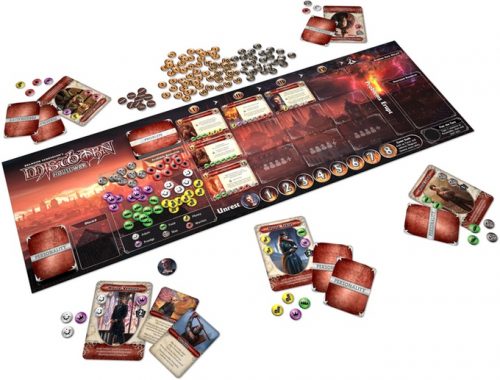
A boardgame based on Brandon Sanderson’s Mistborn novels is up on Kickstarter! A $50 pledge (plus shipping) gets you a copy of the semi-cooperative game. The game is designed by Kevin Wilson (one of my favorite game designers). Check out Mistborn: House War from Crafty Games.
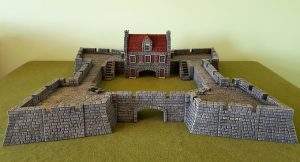 Miniature wargamer? Laser Dream Works is presenting 3D printer-ready models for historical (17th and 18th Century) terrain. The main item (at $45) is a fortress based on Fort Ticonderoga in New York state. The Vauban Fortress is scales from 28mm to 10mm sizes. Already unlocked: battle-damaged walls, outer fortifications, and Spanish-style turrets. They’re so very close to unlocking a five-pointed fort and a shore battery made of curved walls, but they’re in the final week of the campaign, so act soon!
Miniature wargamer? Laser Dream Works is presenting 3D printer-ready models for historical (17th and 18th Century) terrain. The main item (at $45) is a fortress based on Fort Ticonderoga in New York state. The Vauban Fortress is scales from 28mm to 10mm sizes. Already unlocked: battle-damaged walls, outer fortifications, and Spanish-style turrets. They’re so very close to unlocking a five-pointed fort and a shore battery made of curved walls, but they’re in the final week of the campaign, so act soon!
Summit has an interesting theme: mountain climbing. In the game, you’re racing up (and back down) a mountain, laying down tiles to create trails and hazards. But you don’t want to sprint up the mountain: you’ll have to keep track of your food, oxygen, and health while making sure you’re not overburdened or too slow to ascend and descend. You’ll have to watch the weather, balance your load, and survive the perilous trek. The base game is yours for a pledge of $37 (US, approximate: $49 CAD). Summit also comes with a cooperative/solo expansion, which is available at the $49 level ($64 CAD).
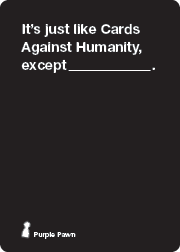
If Cards Against Humanity is dirty words Apples to Apples, Drawing Without Dignity is potty-mouth Pictionary. This week’s Marketplace Confusion/Parody/Coattail Riding spotlight product is for 17 and up (really? 17?) and it’s pretty much Pictionary where you’re drawing things like “sperm donor”, “yellow snow”, and “carpet muncher”. A $25 pledge gets you a box with 100 cards (5 clues per card), a one-minute timer, a six-sided die, a pad of paper, and four miniature golf pencils. Drawing Without Dignity has a week and a half to go and is nearly a third of the way funded: take a look at the campaign.
Hey, remember last time when we featured an 18-card CAH “expansion” called Bad Apples? You’re probably wondering if they funded. Nope, but it’s because the creator cancelled the funding with just two dollars to go! Well, they went ahead and relaunched the campaign again (the third time), and it still didn’t fund, only getting $500 of the C$750 requested.
- Comments Off on Crowdfunding Highlights
3D Printing Roundup
21 Mar
Posted by Rob Kalajian as Classic Board Games, Miniatures, Modern Board Games, Other, RPGs, War Games

By now you’ve probably heard the news that Mattel is entering the 3D printing market with the Thingmaker. The $300 printer is aimed at making it easy to choose items to print and getting them printed. Well now you can pre-order the Thingmaker from Amazon, making it so you can have it to play with as soon as possible.
What’s almost as cool as 3D printing? 3D scanning physical items to be replicated with a 3D printer. Hasbro has a patent out for a device that makes 3D scanning simple using a rotating base and a smartphone. While probably not as precise as the recently Kickstarted Eora 3D, it’ll probably be much more affordable.
Wrapping up, here’s a list of some great looking products you can snag off Wargame Vault and print yourself:
Printable Scenery:
Citadel Tower
Winterdale Blacksmith
Winter dale Bridge Cottage
Winterdale Gnarly Tree Pack
Dungeon Caverns
Fat Dragon Games:
DRAGONLOCK: Dungeon Expansion Set 1
DRAGONLOCK: Dungeon Expansion Set 2
DRAGONLOCK MINIATURES: Lizardfolk Set
Via Ludibunda:
Prices vary on these, but it’s worth it in general since you can print as much as you’d like one you have the files.
- Comments Off on 3D Printing Roundup
Print and Play Part 1: The Micro 3D
17 Oct
Posted by Rob Kalajian as Card Games, CCGs, Classic Board Games, Gamification, Miniatures, Modern Board Games, RPGs, War Games
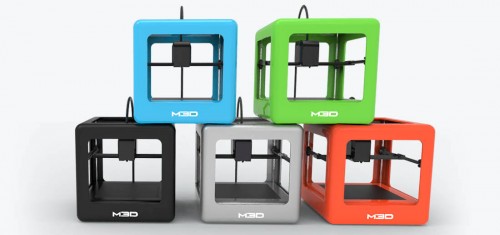
Welcome to the first part of Print and Play, a series I’ve been thinking and working on for quite some time now. Over the past few years I’ve noticed a trend. More and more publishers, designers, and gamers are using 3D printing to create, prototype, or supplement their gaming. There are dozens 3D printers on the market, and more arriving every day. A lot of them are falling into pretty affordable ranges for the average consumer. Hence the first printer in this series, the Micro 3D. My thought was to test every 3D printer I could get my hands on to see how they stack up, and how they could be used in tabletop gaming.
The Micro 3D was a huge success on Kickstarter with over 12,000 backers. The mission of the Micro was to be an attractive, affordable, quality 3D printer for the average consumer. Coming in at only $350, the printer has the following tech specs (take from the Micro 3D site):
“Supports many different materials: ABS, PLA, nylon, professional, chameleon
50-350 micron layer resolution
15 micron X and Y positioning accuracy
Filament: standard 1.75mm. 1/2lb rolls fit within print bed and allow you to try a variety of materials and colors for less! Standard filament rolls also supported.
Print height: 116mm (4.6″)
Base Print Area: 109mm x 113mm
Print Area Above 74mm: 91mm x 84mm
Removable Print Bed Size: 128x128mm
Printer Dimensions: It’s a cube, 7.3 in (185 mm) per side.
Printer weight: 1kg (2.2 lbs)
Package weight: 2kg – 2.7kg (4.4 lbs – 6 lbs)
USB Compatible”
I’ve had a few months to play with the Micro, and it’s impressed me beyond measure. After unboxing the machine I plugged it in, installed the software, and after a quick auto-calibration I was off and printing. No complicated setup. No fiddling with temperature settings, etc. There was already a spool of PLA filament loaded internally into the machine, so it was pretty much plug and play. You may notice the blue painter’s tape on the print bed in the photo above, but the Micro actually comes with a square of Buldtak in place. This actually works way better than painters tape, but I accidentally tore mine while removing a print. I’ll be getting more in the future, but blue painter’s tape works fine in the meantime.
So what did I print? My first few prints were simple Chess pawns. I printed one on the lowest quality setting, one on the highest, and one with a high quality setting, but a low fill setting. Here’s the results.
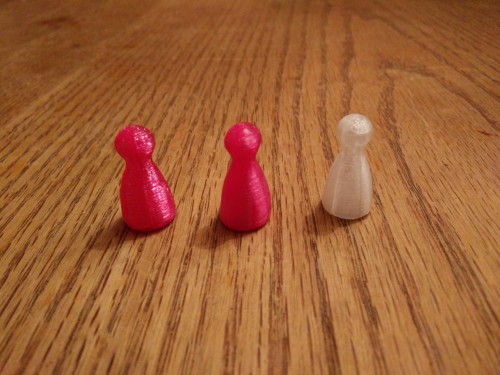 The high quality prints are really nice, and even the low quality looks pretty descent. I ended up doing some other jobs for more functional items in lower quality, while game pieces and such in high quality. After the pawns I tried printing out some stuff from the Open Board Game project, and a Deco Dieselbot miniature. After those, I printed the spaceships from Breach: Starship Duels.
The high quality prints are really nice, and even the low quality looks pretty descent. I ended up doing some other jobs for more functional items in lower quality, while game pieces and such in high quality. After the pawns I tried printing out some stuff from the Open Board Game project, and a Deco Dieselbot miniature. After those, I printed the spaceships from Breach: Starship Duels.
The Open Board Game pieces and the ships came out quite nice, but the Dieselbot’s details came out a bit choppy. It was actually one of the only items I’ve printed so far that I was a bit disappointed how it came out.
I got a bit ambitious after this, and got a project in mind I really wanted to try. My son’s 10th birthday was coming up at the time, and I though it would be really cool to print him out a Minecraft Chess Set. I only had clear and fuscia PLA filament, but I figured I could prime them when I was done printing. 127 hours later, I was done.
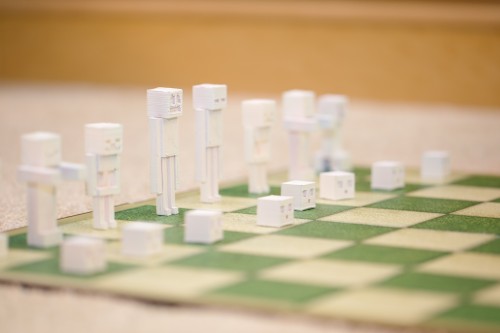 He loved it. I loved it. The plastic primed beautifully, and the prints came out amazing. It took a bit to clean some of the smaller area’s supports off, but that’s nothing a bit of patience couldn’t handle. Of course this brings me to the one real downfall of the Micro 3D. It’s slow. A lot of prints I’ve tested on other machines took twice to four times as long to print. I can’t complain too much, though, because of the ease and consistency of the printer. It really is as easy as a quick setup and you’re on your way. Out of 4 spools of filament’s worth printing, I’ve had maybe 2-3 prints fail.
He loved it. I loved it. The plastic primed beautifully, and the prints came out amazing. It took a bit to clean some of the smaller area’s supports off, but that’s nothing a bit of patience couldn’t handle. Of course this brings me to the one real downfall of the Micro 3D. It’s slow. A lot of prints I’ve tested on other machines took twice to four times as long to print. I can’t complain too much, though, because of the ease and consistency of the printer. It really is as easy as a quick setup and you’re on your way. Out of 4 spools of filament’s worth printing, I’ve had maybe 2-3 prints fail.
Last, but certainly not least, I started thinking of printing some adaptive game accessories. My wife and I run a social communications game group, and I was trying to think of ways I could improve some of the kids’ gaming experience. The first though that came to mind was something to help them hold hands of cards. A quick search and I found a great card holder. It was a bit large for the Micro, but I was easily able to scale it down with their software to produce something that has worked like a charm.
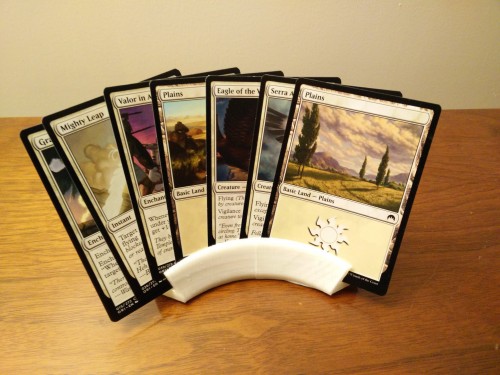 Since then, I’ve also printed some larger meeples that are easier to hold, along with card and dice trays.
Since then, I’ve also printed some larger meeples that are easier to hold, along with card and dice trays.
The Micro has helped me learn a lot about 3D printing, and set a nice standard for me to compare other printers to. It’s ease of use, simple setup, and consistent printing more than make up for the slower print times. The price isn’t too shabby, either. It’s an amazing little workhorse, and I’ve actually done a lot of printing that isn’t gaming related, too. My next project is to help a local designer buddy of mine print some pieces out for his prototypes. It’s an exciting project, and I can’t wait to share the results.
Micro 3D – $350
Pros: Price, ease of use/setup, consistent
Cons: Speed
Overall Verdict: Excellent
A demo Micro 3D unit and 2 spools of filament were provided for this review.
CreatorBlocks 3D Printed Open Source Isometric Board Game Creator
26 Jun
Posted by Rob Kalajian as Miniatures, Modern Board Games, War Games
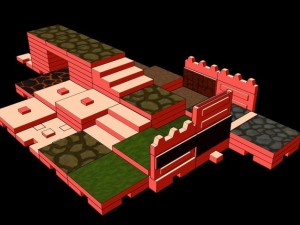 Here’s yet another system that can be used to make your own games, miniatures terrain, RPG maps, and more. CreatorBlocks is a set of modular pieces that can be 3D printed and assembled in a multitude of fashions. The system is very flexible, with both square and hex tiles plus supporting pieces for each. There’s walls, floors, different textures, and a lot of other customizable features.
Here’s yet another system that can be used to make your own games, miniatures terrain, RPG maps, and more. CreatorBlocks is a set of modular pieces that can be 3D printed and assembled in a multitude of fashions. The system is very flexible, with both square and hex tiles plus supporting pieces for each. There’s walls, floors, different textures, and a lot of other customizable features.
The best part? The system is open source, so you can feel free to modify and of the pieces in a way you see fit. Designer Anthony Davila has put everything you need to get started up on Thingiverse.
I’ve got a few pieces queued up to print now so I can see how it all fits together.
- Comments Off on CreatorBlocks 3D Printed Open Source Isometric Board Game Creator
It is natural to think of Kickstarter when hearing “crowdfunding”, especially for people who love to play games. As a platform to raise funds for a project, Kickstarter is great, but what if you want to support a creator in his or her ongoing work? For that, we turn to Patreon. At the site, creators can list what they’re creating and what they’ll be paid for. Patrons choose how much they’ll give per work created, which is paid monthly, and can cap their monthly patronage.
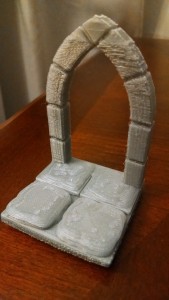 Brent Newhall is creating 3D printable miniature files. Each release includes at least “one 3D-printable miniature as an STL file” that can be used to produce the miniature(s). The files will be released free to download and edited by other 3D modelers. Don’t have a 3D printer? At the $5 per miniature patron level, Brent will print and mail you miniatures.
Brent Newhall is creating 3D printable miniature files. Each release includes at least “one 3D-printable miniature as an STL file” that can be used to produce the miniature(s). The files will be released free to download and edited by other 3D modelers. Don’t have a 3D printer? At the $5 per miniature patron level, Brent will print and mail you miniatures.
James E. Shields is creating stock art for RPGs. In this Patreon, he’ll draw quarter-page illustrations based on submissions suggestions from his patrons. Once created, the artwork is available for use, royalty-free. All of James’ listed patronage levels include the ability to suggest subjects for future illustrations.
Daniel Solis is creating vector icons for use in board game and roleplaying game design. He releases a set of black and white icons in .eps format under a Creative Commons CC-BY license allowing you to do what you will with the icons. (“Be free, icons!”) Daniel suggests a $5 patronage level, but at $20, he provides access to several “tips, tutorials, and templates to make your layout jobs a bit easier”.
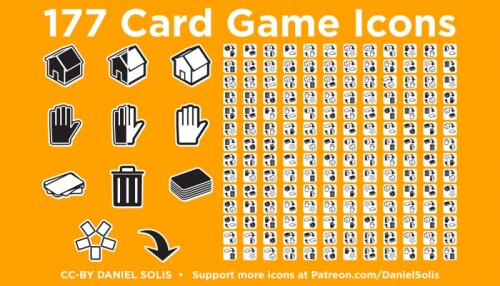
Tracy Barnett is creating small games and stories. With a goal of 2-4 creations a month (“microgame, short story, or collection of a few flash stories”), Tracy also provides audio files to support the creations: actual play recordings and audio commentary tracks. Also included is a look at the development of the Patreon’s creations. Tracy suggests a $2 per creation patronage level.
Starlit Citadel is using Patreon to fund their board game review series. The video series comes from a Canada-based online game store and has become rather popular as a gaming review series. However, that’s worked to their disadvantage as the majority of viewers (85.7%) are outside of Canada, and “the amount of sales the videos have generated for the store does not justify the expense of the videos.” Rather than end the series, the store turned to Patreon to fund a season four. While the company has reached its funding goal of $450 per episode, any additional amount pledged will go directly to improving the series by purchasing better equipment, arranging for a special episode with a guest star, or being able to improve the production values. They offer a $1 patronage level.
Are you a Patreon creator and would like to let us know about your project? Contact thomas@purplepawn.com and tell us about it!
3-D Printing the Monster Manual: WotC Says Stop, WotC Says Go
06 May
Posted by Thomas Deeny as Miniatures, Other, RPGs
Let’s say you have a 3D printer and you like Dungeons & Dragons. You start creating your own 3D models of monsters featured in the Monster Manual, showcase them on reddit/r/dnd, and share the files with others on Thingiverse, a 3D printing community. And then Wizards of the Coast files a Digital Millennium Copyright Act notice, making Thingiverse remove those files.
If you’re a Reddit user going by the username mz4250, this might sound familiar.
Before the DMCA notice, mz4250 created several miniatures inspired by creatures found in various Monster Manuals, and promoted images of them in threads titled “3D Printing the Monster Manual“. Goofy images like the Dread Gazebo appeared alongside basic monsters like the Shrieker, Displacer Beast, and Demons in his imgur albums for weeks. Then the DMCA notice came and his 3D files were removed.
Initially thinking the issue came from basing the designs on WotC’s artwork and despairing that his work might not be legally available again, he contacted WotC to see what could be done. To his surprise, Wizards “want me to continue modeling and printing their monsters” and to make his modeling files available. But because Hasbro, which owns WotC, has an agreement with Shapeways, another 3D printing community, to host and print fan art, they needed the files to be hosted there. “WOTC has pleasantly surprised me this week,” he writes. “I’m happy they were pretty reasonable in the end.”
So a happy ending for mz4250, as he gets to continue sharing 3D models (at Shapeways.com/designer/mz4250) and developing more. He posts more of his work in the D&D subreddit at reddit.com/r/dnd.
- Comments Off on 3-D Printing the Monster Manual: WotC Says Stop, WotC Says Go
Open Board Game lets you 3-D print your own tabletop board game
25 Mar
Posted by Lory Gilpatric as Modern Board Games
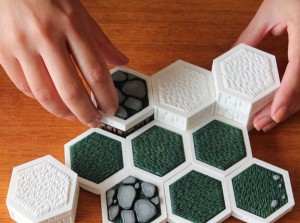 Game development company Thinker Thing is in the process of developing a full community of free downloadable plans for 3-D printing your own board game. The open source project, called Open Board Game, is designed to allow both creators and players participate in the process. With the framework, creators will be able to upload the models to the website and players will be able to download them to make physical pieces on a 3-D printer.
Game development company Thinker Thing is in the process of developing a full community of free downloadable plans for 3-D printing your own board game. The open source project, called Open Board Game, is designed to allow both creators and players participate in the process. With the framework, creators will be able to upload the models to the website and players will be able to download them to make physical pieces on a 3-D printer.
According to 3DPrint, the framework is a set of components, like interlocking board tiles, mini figs, cards, dice, and even electronic elements, all of which can be printed at home using a 3-D printer.
Currently, the website features free 3-D printer download models for two games; Miomon, which is a monster-capture card game similar to Pokémon, and Rust to Dust, which is an advance wars type strategy game. Rust to Dust is in its first playable state and Miomon is still in the early concept stage.
The idea, however, is to have the public create their own games and publish the models to the website so that others can print-and-play for free. We aren’t talking about a PDF of a card game, either. These are detailed 3-D game pieces, stuff you’ll have to keep in a box.
If you don’t have your own 3-D printer at home, the Open Board Game website recommends a few websites that will print your products for you, like Maker Space, FabLabs, and 3D Hubs. Or, you can ask your local library if a 3-D printer is available to the public.
If this takes off, 3-D printed board games could be the next big thing in the industry.
- Comments Off on Open Board Game lets you 3-D print your own tabletop board game
Hasbro Opens 3D Printing to Game Properties
27 Aug
Posted by David Miller as Modern Board Games, RPGs
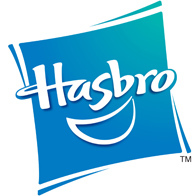 Hasbro, which recently initiated a program that allows fans to sell 3D-printed My Little Pony designs via Shapeways, is now expanding that program, called SuperFanArt, to three game brands: Dungeons & Dragons, Monopoly, and Scrabble.
Hasbro, which recently initiated a program that allows fans to sell 3D-printed My Little Pony designs via Shapeways, is now expanding that program, called SuperFanArt, to three game brands: Dungeons & Dragons, Monopoly, and Scrabble.
Independent artists will have to sign a SuperFanArt (Hasbro) Artist Agreement but can set their own prices.
To be featured in the launch of the new game brands, artists should submit their designs by September 9th.
- Comments Off on Hasbro Opens 3D Printing to Game Properties
Trending
- Massdrop.com
- Oh the Irony—Illuminati Card Game Continues to Inspire Conspiracy Theorists
- Footprints, an Educational Ecology Game
- USPS Adds Board Game Flat Rate Box
- Home
- Baila, the Estonian Drinking Card Game
- Crystal Caste Wins Dice Patent Suit Against Hasbro
- Mirror Game, Red and Blue
- Hasbro and Mattel Merger?
- Are Board Games Dangerous?
Archives
Most Popular Articles
- Oh the Irony—Illuminati Card Game Continues to Inspire Conspiracy Theorists
- The 20 Most Valuable Vintage Board Games
- The Truth About Dominoes On Sunday in Alabama
- Sequence Game, and Variants
- USPS Adds Board Game Flat Rate Box
- Baila, the Estonian Drinking Card Game
- The 13 Most Popular Dice Games
- Are Board Games Dangerous?
- Guess Who? The Naked Version
- What Happened to the Jewel Royale Chess Set?
Recent Posts
- Toy Fair 2019—Breaking Games
- Talisman Kingdom Hearts Edition
- Toy Fair 2019—Winning Moves
- Toy Fair 2019—Games Workshop
- Toy Fair 2019—Star Wars Lightsaber Academy
- Toy Fair 2019—Stranger Things Games
- Toy Fair 2019—HABA
- Licensing Roundup
- Game Bandit
- 2018 A Difficult Year For Hasbro But Not For D&D Or MtG
Recent Comments
- on Toy Fair 2019—Winning Moves
- on Game Bandit
- on Second Look—Dungeons & Dragons Waterdeep Dragon Heist
- on Crowdfunding Highlights
- on Beyblade SlingShock
- on Game Bandit
- on Game Bandit
- on Watch This Game!, the Board Game Review Board Game
- on Second Look—Vampire: The Masquerade 5th Edition
- on Palladium Books Loses Robotech IP License, Cancels Five-Year-Overdue Robotech RPG Tactics Kickstarter

